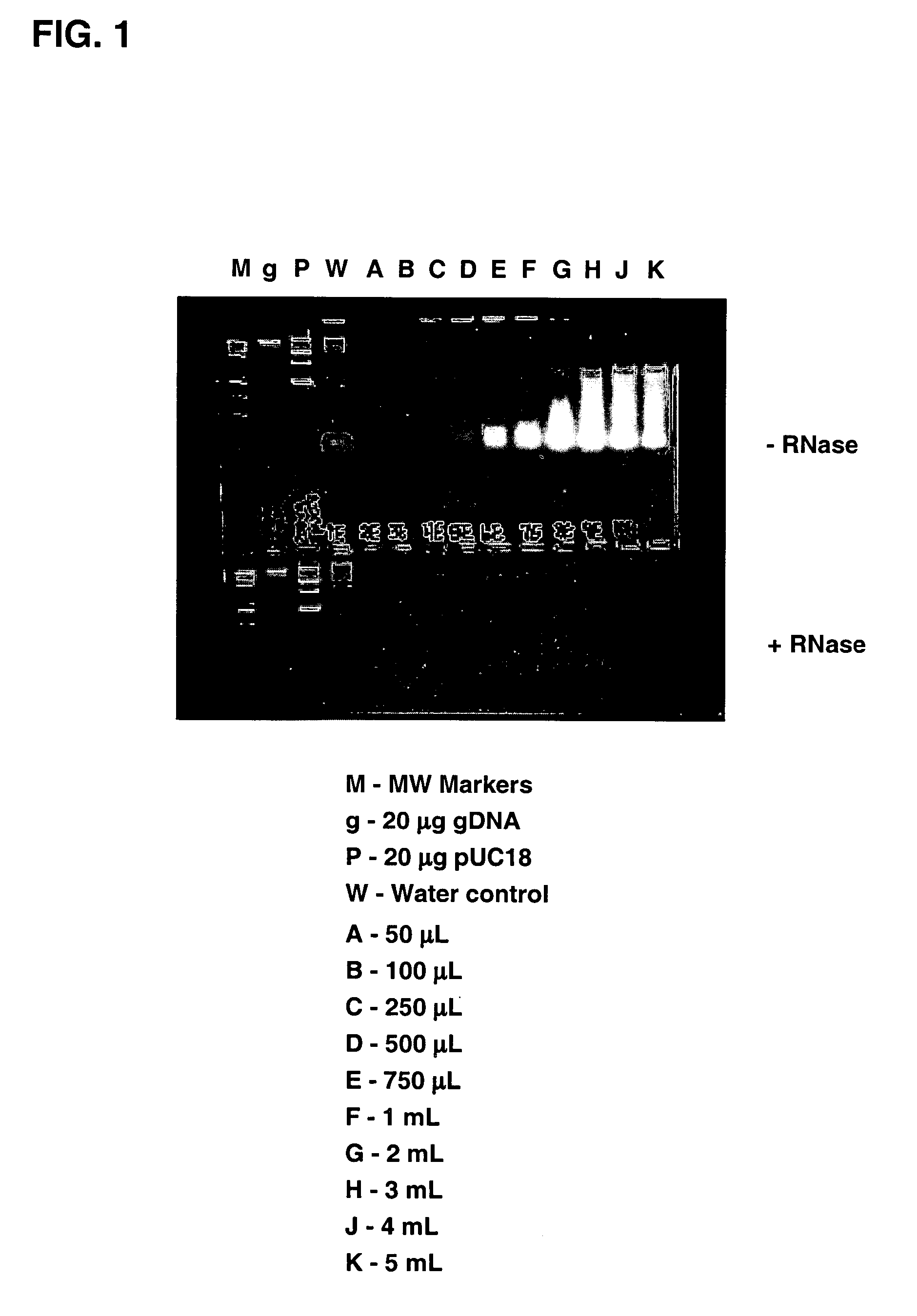Methods of enhancing isolation of RNA from biological samples
a technology of ribonucleic acids and isolation methods, applied in the field of enhanced isolation of rna, can solve the problems of complicated clinical practice use of rna, cumbersome multi-step nature of the above methods for isolating rna,
- Summary
- Abstract
- Description
- Claims
- Application Information
AI Technical Summary
Benefits of technology
Problems solved by technology
Method used
Image
Examples
example 1
Synthesis of 4′-Hydroxyphenyl 4-chloromethyl-thiobenzoate
[0070] A 3 L flask was charged with 100.9 g of 4-chloromethyl-benzoic acid and 1.2 L of thionyl chloride. The reaction was refluxed for 4 h, after which the thionyl chloride was removed under reduced pressure. Residual thionyl chloride was removed by addition of CH2Cl2 and evaporation under reduced pressure.
[0071] A 3 L flask containing 113.1 g of 4-chloromethylbenzoic acid chloride was charged with 98.17 g of 4-hydroxy-thiophenol and 1.5 L of CH2Cl2. Argon was purged in and 67.75 mL of pyridine added. After stirring over night, the reaction mixture was diluted with 1 L of CH2Cl2 and extracted with a total of 5 L of water. The water layer was back extracted with CH2Cl2. The combined CH2Cl2 solutions were dried over sodium sulfate and concentrated to a solid. The solid was washed with 500 mL of CH2Cl2 filtered and air dried. 1H NMR (acetone-d6): δ 4.809 (s, 2H), 6.946-6.968 (d, 2H), 7.323-7.346 (d, 2H), 7.643-7.664 (d, 2H), 8...
example 2
Synthesis of Magnetic Silica Particles Functionalized with Polymethacrylate Linker and Containing Tributylphosphonium Groups and Cleavable Arylthioester Linkage
[0072]
[0073] Magnetic carboxylic acid-functionalized silica particles (Chemicell, SiMAG-TCL, 1.0 meq / g, 1.5 g) were placed in 20 mL of thionyl chloride and refluxed for 4 hours. The excess thionyl chloride was removed under reduced pressure. The resin was resuspended in 25 mL of CHCl3 and the suspension dispersed by ultrasound. The solvent was evaporated and ultrasonic wash treatment repeated. The particles were dried under vacuum for further use.
[0074] The acid chloride functionalized particles were suspended in 38 mL of CH2Cl2 along with 388 mg of diisopropylethylamine. 4′-Hydroxyphenyl 4-chloromethyl-thiobenzoate (524 mg) was added and the sealed reaction flask left on the shaker over night. The particles were transferred to a 50 mL plastic tube and washed repeatedly, with magnetic separation, with portions of CH2Cl2 / CH3...
example 3
Agent Compounds Used in Isolation of Nucleic Acids
[0076] A compound having the formula:
and designated Compound 1 was evaluated for its effect on nucleic acid binding and release. The preparation of Compound 1 was described in U.S. Pat. No. 5,439,617.
[0077] Compounds 2 and 3 are polymers prepared as described in U.S. Pat. No. 5,393,469.
Compound 2: R=n-butyl; Compound 3: R=3:1 ratio of n-butyl and n-octyl; X is Cl; substitution is predominantly in the para-position.
PUM
| Property | Measurement | Unit |
|---|---|---|
| size | aaaaa | aaaaa |
| pH | aaaaa | aaaaa |
| pH | aaaaa | aaaaa |
Abstract
Description
Claims
Application Information
 Login to View More
Login to View More - R&D
- Intellectual Property
- Life Sciences
- Materials
- Tech Scout
- Unparalleled Data Quality
- Higher Quality Content
- 60% Fewer Hallucinations
Browse by: Latest US Patents, China's latest patents, Technical Efficacy Thesaurus, Application Domain, Technology Topic, Popular Technical Reports.
© 2025 PatSnap. All rights reserved.Legal|Privacy policy|Modern Slavery Act Transparency Statement|Sitemap|About US| Contact US: help@patsnap.com



